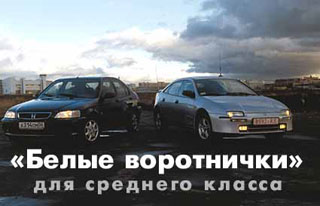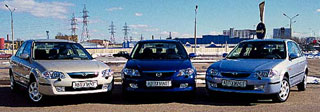Test Drive Mazda 323 F 1994 - 1997 Hatchback
Portrait on rivals background
Everything comes to comparison ... Guided by this, we went to the autopoligon, to meet the most-domestic VAZ 21103 car with its foreign classmates.When preparing for this test, there was a surprise. It turns out that real classmates are not so many of the third, but the reason is that one and a half liters (let it not seem strange) rather rare engine. Most European and Japanese manufacturers make 1.4 and 1.6 liters. Only in Korea is distributed 1.5-liter, which is associated with the current tax system there.
Get acquainted with competitors
 All VAZ 21103 classmates presented in our test - sedans and all under the hoods are 1.5-liter 16-valve motors with a distributed gasoline injection. It is curious that foreigners are a bit larger than dozen - by 50-170 mm longer and 15-31 mm wide, moreover, they have a wider track (on average by 100 mm) and a long wheelbase (Honda has 128 mm more than at VAZ 21103).
All VAZ 21103 classmates presented in our test - sedans and all under the hoods are 1.5-liter 16-valve motors with a distributed gasoline injection. It is curious that foreigners are a bit larger than dozen - by 50-170 mm longer and 15-31 mm wide, moreover, they have a wider track (on average by 100 mm) and a long wheelbase (Honda has 128 mm more than at VAZ 21103). KIA Sephia II has been produced since 1998, the BFD - power unit of the former Mazda-323 of the two camshafts (drive of the toothed belt) and the adjustable catalytic neutralizer. The compression ratio is 9.3.
Mazda 323 since 1998, the modernized engine has a similar block of cylinders, equipped with an adjustable catalytic neutralizer. The degree of compression is 9.4.
Honda Sivik in production Since 1995, an engine with one camshaft (drive with a toothed belt) is equipped with a V-TEC valve control system and located immediately for the exhaust manifold adjustable neutralizer. Compression ratio - 9.6.
VAZ 21103 In the series since 1998, the VAZ 2112 engine with two camshafts (drive with a toothed belt), without a catalytic neutralizer. The degree of compression is 10.5.
Taste, on color ...
 None of these cars will not be called inappropriate, but this is perhaps the only thing that can be considered common in their appearance. Its calm, rounded forms of Sephia II is not at all similar to Mazda, balancing on the verge of angularity, and a clear wedge-shaped silhouette of Sivik with a low sloping hood and outstanding wheeled arches is hardly at least a hint of both of them. The most controversial design of Mazda, two other foreign cars produce a positive impression. On this background, one hundred and third reminds the miniature submarine thrown onto the land: a massive barrel body with a small glass cabin, a wide rounded side of the sidewall, in deep dark cuts of wings - wheels with almost deaf discs. The most diplomatic definition for its appearance is an original avant-garde.
None of these cars will not be called inappropriate, but this is perhaps the only thing that can be considered common in their appearance. Its calm, rounded forms of Sephia II is not at all similar to Mazda, balancing on the verge of angularity, and a clear wedge-shaped silhouette of Sivik with a low sloping hood and outstanding wheeled arches is hardly at least a hint of both of them. The most controversial design of Mazda, two other foreign cars produce a positive impression. On this background, one hundred and third reminds the miniature submarine thrown onto the land: a massive barrel body with a small glass cabin, a wide rounded side of the sidewall, in deep dark cuts of wings - wheels with almost deaf discs. The most diplomatic definition for its appearance is an original avant-garde. What is inside?
 No, wait until the characteristics of the motors we still get, and to start in detail the machine's salons in detail. Here, as well as outside, not everything is simple, in any case, what they see, not always consistent with what the boarding mannequin says. At first glance, the most spacious salon in Mazda, which, in general, is true. However, the spacious does not mean wide: in width with a noticeable margin leads Sephia, behind it - VAZ 21103, the narrowest - Sivique. Not too stuffy passengers can easily settle down in the back seat in all machines, but ... in the top ten, you will have to sign the headband head: at the top of the interior is very narrow. The right front armor of Mazda is equipped with an additional hinge, which allows you to pop up a back forward, turning it into a table - a rare, but convenient solution. However, it is more important for us how good to those who are driving.
No, wait until the characteristics of the motors we still get, and to start in detail the machine's salons in detail. Here, as well as outside, not everything is simple, in any case, what they see, not always consistent with what the boarding mannequin says. At first glance, the most spacious salon in Mazda, which, in general, is true. However, the spacious does not mean wide: in width with a noticeable margin leads Sephia, behind it - VAZ 21103, the narrowest - Sivique. Not too stuffy passengers can easily settle down in the back seat in all machines, but ... in the top ten, you will have to sign the headband head: at the top of the interior is very narrow. The right front armor of Mazda is equipped with an additional hinge, which allows you to pop up a back forward, turning it into a table - a rare, but convenient solution. However, it is more important for us how good to those who are driving. Everything is simple and understandable here: the driver's workplace in foreigners is almost the same, only the seats differ. The best in shape - in Mazda, a little worse than the back of Kia, the Hondovsky chair - an example of how to do not need: the pillow is short, too soft and absolutely horizontal. Even the successful design of the back is not able to change the impression. But the one hundred and third in this part is all right, but ... the move of the longitudinal adjustment of the seat is too small, and the driver is tall above 185 cm
It would be a hollow, and the woodpecker there
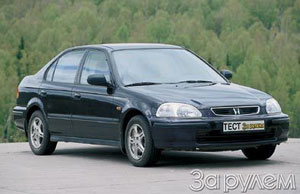 It seems that little trunks in the sedans were ever sunk in the fly. Which of our four do not look, hollow - what you need. The back seat is, of course, everyone adds in parts, and hence it is still possible to increase the volume of the cargo compartment. Perhaps only Sephia may not have the right to brag about the capacity of his trunk. But it can make a hundredth third - there is no equal. Here is just the loading height (the distance from the lower edge of the opening of the luggage compartment to the asphalt) is the largest, and load the hold is from above, which is not too comfortable when things are large and heavy. However, the KIA is not without sin: its luxurious rear lights limit the width of the opening, and the trunk lock is a clear threat to the nape. The designers concluded it into the plastic case and provided a warning inscription, but it is usually possible to see it only over the tenth of a second to contact the nape with the lock. The consequences of such a meeting in print usually do not comment due to abnormative vocabulary. But to the trunkings of Honda and Mazda claims simply not.
It seems that little trunks in the sedans were ever sunk in the fly. Which of our four do not look, hollow - what you need. The back seat is, of course, everyone adds in parts, and hence it is still possible to increase the volume of the cargo compartment. Perhaps only Sephia may not have the right to brag about the capacity of his trunk. But it can make a hundredth third - there is no equal. Here is just the loading height (the distance from the lower edge of the opening of the luggage compartment to the asphalt) is the largest, and load the hold is from above, which is not too comfortable when things are large and heavy. However, the KIA is not without sin: its luxurious rear lights limit the width of the opening, and the trunk lock is a clear threat to the nape. The designers concluded it into the plastic case and provided a warning inscription, but it is usually possible to see it only over the tenth of a second to contact the nape with the lock. The consequences of such a meeting in print usually do not comment due to abnormative vocabulary. But to the trunkings of Honda and Mazda claims simply not. Whose motor is better?
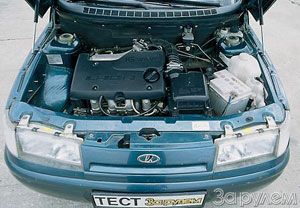 We did not set their goal to compare engines in the separation from the cars themselves. After all, the driver of the motor and torque driver judges at maximum speed and overclocking dynamics. We did the same, understanding, of course, that the transmission parameters and the car itself also play a considerable role.
We did not set their goal to compare engines in the separation from the cars themselves. After all, the driver of the motor and torque driver judges at maximum speed and overclocking dynamics. We did the same, understanding, of course, that the transmission parameters and the car itself also play a considerable role. The most powerful car is Sivique, and we did not expect the highest results without reason. This was partly confirmed: Honda became the leader at maximum speed and elasticity in the fourth gear. On the fifth, she missed the Mazda with her own trap engine and short gears, which became the winner and accelerate to 100 km / h. VAZ 21103 In this discipline ranked third, but showing the only result that exceeds the factory data. Kia lost to rivals in all nominations, despite smooth, without failures and pickups, engine craving in the entire range.
It was pleasantly surprised that the maximum speed measured at the landfill was only 3.5 km / h less than that of Honda, on a passport with an impressive advantage - 20 liters. from.! This is undoubtedly
 certificate of very good aerodynamics of the VAZ car, which, by the way, is confirmed by the longest elected. And if we take into account its considerable, compared with foreigners, road clearance, which does not contribute to the reduction of air resistance, the results of the labor of domestic aerodynamics specialists can be called outstanding without false modesty.
certificate of very good aerodynamics of the VAZ car, which, by the way, is confirmed by the longest elected. And if we take into account its considerable, compared with foreigners, road clearance, which does not contribute to the reduction of air resistance, the results of the labor of domestic aerodynamics specialists can be called outstanding without false modesty. Honestly, the characteristic of the motor one hundred and third did not disappoint us. It was obvious that when it was created, it was sought to make a smooth engine capable of driving in the dirt and at the same time alive in high speed. It would have managed, do not cross all the efforts of developers main steam with a gear ratio of 3.706. The car is extremely difficult to maximize the speed, and elasticity on the fifth gear leaves much to be desired - even a small rise requires switching. I would like to recall that the hobby of designers too long the main couples has already created a bad fame to one domestic car ... So why not learn from other errors?
And yet: foreigners without visible difficulties take gasoline AI-92, and our one hundred and third uses it as a student vodka - drinks, but wrinkles. Its standing after a quiet ride to step on the accelerator more accurately, as a characteristic link-bryak is heard from under the hood ... it is pretty, but quite explained - the VAZ 2112 motor is the highest compression ratio. Or you just need to create a normal engine control program?
Where does the curve take out?
 Smart acceleration is, of course, great, well, how is the brakes? Honda and Mazda with ABS demonstrated a magnificent slowdown: 9.6-9.7 m / s2, Kia without ABS looked somewhat worse, although quite acceptable - 8.4-8.5 m / s2. The characteristics of the VAZ 21103, despite the ventilated front discs, were not at all at a height: 6.7-6.9 m / s2 when braking from 100 km / h. However, having some experience testing brake pads, we can assume that it is not necessarily in braking mechanisms. Perhaps you should play pads?
Smart acceleration is, of course, great, well, how is the brakes? Honda and Mazda with ABS demonstrated a magnificent slowdown: 9.6-9.7 m / s2, Kia without ABS looked somewhat worse, although quite acceptable - 8.4-8.5 m / s2. The characteristics of the VAZ 21103, despite the ventilated front discs, were not at all at a height: 6.7-6.9 m / s2 when braking from 100 km / h. However, having some experience testing brake pads, we can assume that it is not necessarily in braking mechanisms. Perhaps you should play pads? A little about the suspension. It is known that handling and comfort are bad neighbors, and any road car - an inevitable sacrifice of a compromise. True, the latter is successful and not very ... According to the first impressions, Honda looks good - the car confidently stands on the road, even at the limit of the coupling properties of the tire and is very comfortable. But for the delicacy of the suspension, it is necessary to pay it low energy intensity: it often works until it stops. Direct opposite - Kia: Here the suspension is the toughest, meticulously transfers small irregularities, but the car obedient at any speed, vividly responds to the steering wheel and does not ask too much to slow down before turning. In general, energy intensity at height: it is necessary to try to try hard that the suspension stoppers joined the case. It seems to be the most reasonable compromise represents Mazda,
 but you don't want to quickly pass the turns on it at all. Finally, VAZ 21103. The smoothness of the progress is even better than Honda, and the suspension joking swallows such yambs, from one species of which is not in itself. The energy intensity is above all silence. Is it really ideal? Alas, pay for the long-time and rather soft suspension accounts for anything delicate - handling. Strong rolls in turns, delay with sharp maneuvers, deep, sharp drifts, inaccurate steering wheel - all this does not adorn the car.
but you don't want to quickly pass the turns on it at all. Finally, VAZ 21103. The smoothness of the progress is even better than Honda, and the suspension joking swallows such yambs, from one species of which is not in itself. The energy intensity is above all silence. Is it really ideal? Alas, pay for the long-time and rather soft suspension accounts for anything delicate - handling. Strong rolls in turns, delay with sharp maneuvers, deep, sharp drifts, inaccurate steering wheel - all this does not adorn the car. What is the result?
If you distract from what is called the quality of manufacture, VAZ 21103 looks quite worthily against the background of imported classmates. Yes, and the motor is also not bad. And yet, if there is an impartially to look at the car, claiming the title of the domestic grant tourism, it seems that those who have created it, very little communicated with each other - from quite successful components it turned out far from the most worthy conglomerate. For real competition, additional equipment will be required: ABS, power steering, air conditioning. It is desirable that the quality of the assembly rose at least to the level of Uzbek Nexia. As for the shortcomings of the chassis, they are easily corrected. At least tuning firms are already taken for it. With one hundred and third, they will not be left without work.
SUMMARY
Kia Sephia II.
Do not take a character, although there is something to learn from others.
Mazda 323.
Quality, reliability and art of compromise.
Honda Sivik.
A song motor and the highest quality, not surpassed by other dough participants.
VAZ 21103.
Woven from contradictions, but maybe they are solvable. We'll have to hit legs strongly. And yet: the left leg even the modest 43th size is constantly clinging behind the lower edge of the front panel - not deadly, but unpleasant.



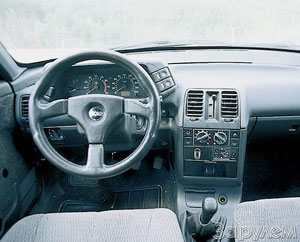








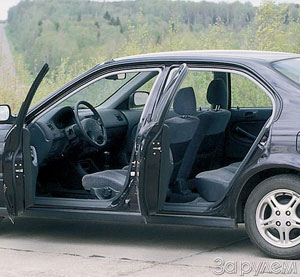
Anatoly Fomin. Photo Sergey Ivanov
A source: Journal "Behind the wheel"

